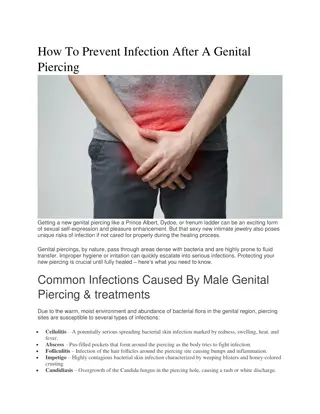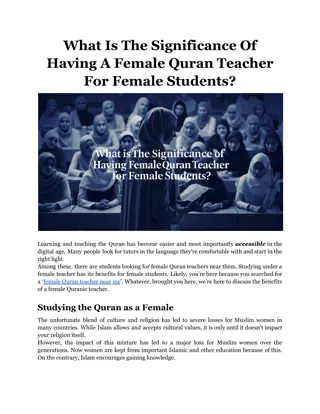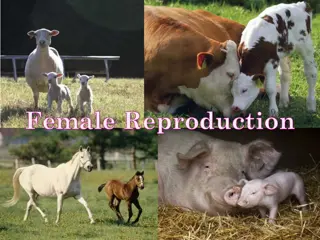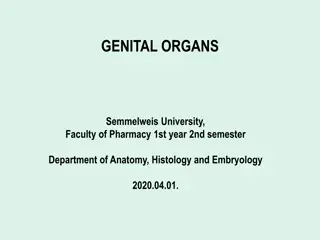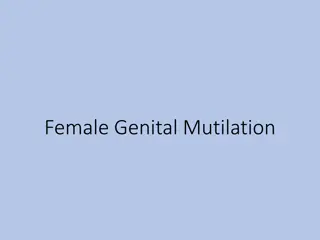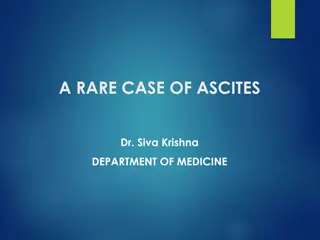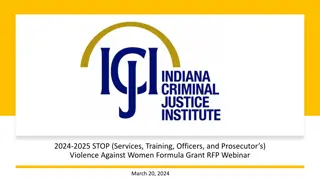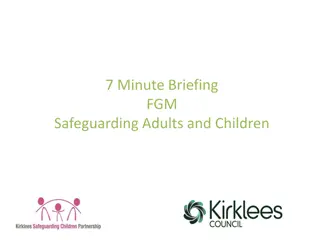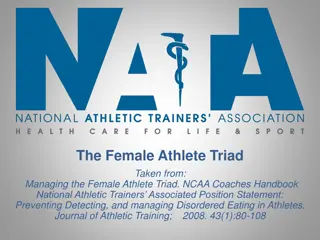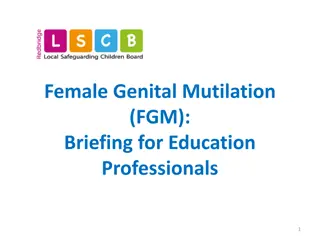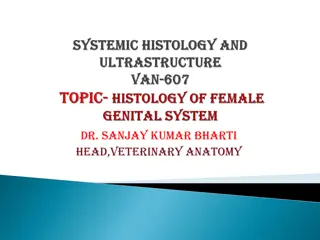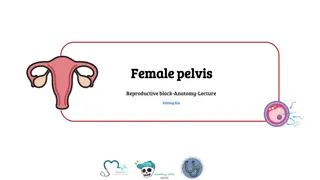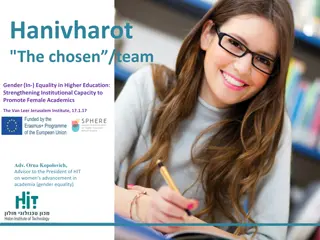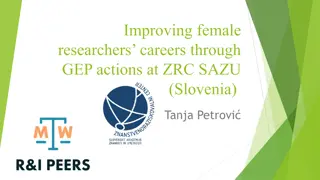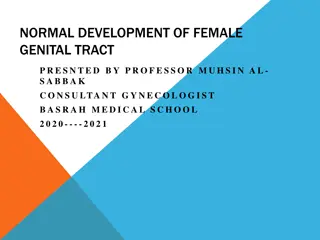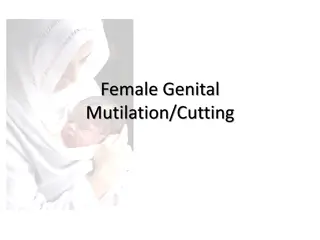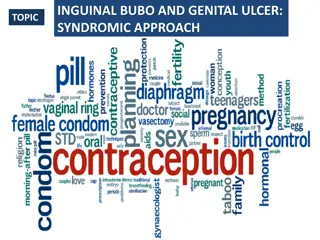Understanding Female Genital Mutilation: Clinical Perspectives
Delve into the complexities of Female Genital Mutilation (FGM) through clinical evaluations and updates. Addressing the sensitive nature of FGM, this content highlights the importance of providing support and information to those affected, focusing on clinical staff responsibilities and key messages. Gain insights into the different types of FGM procedures and the challenges faced, illustrated through real-life cases. Enhance your knowledge on FGM and contribute to creating a supportive environment for affected individuals.
Download Presentation

Please find below an Image/Link to download the presentation.
The content on the website is provided AS IS for your information and personal use only. It may not be sold, licensed, or shared on other websites without obtaining consent from the author. Download presentation by click this link. If you encounter any issues during the download, it is possible that the publisher has removed the file from their server.
E N D
Presentation Transcript
Clinical Evaluation Child Sexual Abuse One Day Advanced Update Clinical Evaluation Child Sexual Abuse One Day Advanced Update Stirling Court Hotel, Stirling Friday 29 Stirling Court Hotel, Stirling Friday 29th thSeptember 2017 September 2017 Susan Kidd Susan Kidd
New subject to many in audience By it s very nature, potentially upsetting subject Violent and degrading act Normalisation within cultures Likely to be people who are affected by FGM, directly or indirectly in many settings Sources of information and support
Address sensitively and respectfully Setting a tone for further learning and work Women/ families affected by FGM must be given Information, care, support Not pity Not stigmatisation
Focus on clinical staff, and FGM related clinical knowledge, skills and responsibilities Illustrative Case Key messages Some pathways and resources
Paediatrician at interagency meeting with police and SW and community group in Edinburgh We believe this 2 yr old girl is at risk of FGM, as her mother has had FGM, and we do not know parent s views or understanding of the subject
Female Genital Mutilation all procedures that intentionally alter or cause injury to the female genital organs for non-medical reasons
Type 1: Clitoridectomy: partial or total removal of the clitoris and, in very rare cases, only the prepuce Type 2: Excision: partial or total removal of the clitoris and the labia minora, with or without excision of the labia Type 3: Infibulation: narrowing of the vaginal opening through the creation of a covering seal. The seal is formed by cutting and repositioning the inner, or outer, labia, with or without removal of the clitoris. Type 4: Other: all other harmful procedures to the female genitalia for non-medical purposes, e.g. pricking, piercing, incising, scraping and cauterizing the genital area.
All types are harmful and treated the same way in terms of child protection and law Symptoms may vary depending on type All types are harmful physically and psychologically It can be difficult to assign a type, even after specialist examination
Best practice is to describe what you can see, what you cannot seen, what looks normal, what does not. Best practice is to describe what you can see, what you cannot seen, what looks normal, what does not. It may be impossible to categorise by WHO system It may be impossible to categorise by WHO system Don t panic! Don t panic!
A mother who has had FGM, is regarded as a significant risk indicator for her daughter(s)
The parents are from Somalia, and came to this country via Holland.
FGM has also been documented in communities including: Iraq Israel Oman the United Arab Emirates the Occupied Palestinian Territories India Indonesia Malaysia Pakistan
eg Nigeria 2.7 % NE 53.4 % SW Girls of Nigerian origin represent the largest single group of at risk girls in Scotland
in 2012, 733 children were born in Scotland to mothers from an FGM-practicing country, of which, 363 were girls. we can approximate a minimum additional 700 children per year born into communities living in Scotland potentially affected by FGM. Tackling FGM in Scotland. A Scottish model of intervention. 2014. Page 14
The 2011 census records the following number of people from countries where FGM is traditionally practised: Glasgow City 8,861; Aberdeen City 4,246; Edinburgh City 3,587; and Dundee City 1,130.
Maternity; about 50 women per year who have experienced FGM Community groups; 70 at risk girls all ages in last year Arbitrary; window / tip of iceberg Schools data; ?1000 school aged girls Pre-school; ?200 + new to area
FGM is observed in Syria, particularly in its Kurdish, Shafi'i and minority Muslim groups. WADI report; >80% of Kurdish women have had FGM, >30% of graduates. Glasgow one of largest centres for refugees in UK, with constant flux to other areas of Scotland
the family have little English and are isolated More likely to hold traditional beliefs, such as FGM, and be unaware of health, media and campaigning information about FGM (But educated and affluent families still frequently affected by FGM)
Most parents arranging to have FGM carried out on their daughters love them wholeheartedly, have their interests at heart and believe it is the best thing for them. Today s girls may be the first in hundreds of generations not to have FGM
NO Highly variable Purity/ marriage prospects/ right of passage Complex Ancient origins Emotive Control of sexuality and women s bodies
1. FGM is child abuse 2. FGM is against the law 3. All health care professionals have a responsibility to be aware and respond appropriately
FGM is a violation of a childs rights and is a child protection issue. It is considered to be a form of gender based violence against women and girls and is managed in accordance with existing child and adult protection structures, policies and procedures. ...child protection is everybody s job... ...child protection is everybody s job...
severe pain emotional and psychological shock (exacerbated by having to reconcile being subjected to the trauma by loving parents, extended family and friends) haemorrhage wound infections, including tetanus and blood borne viruses (including HIV and Hepatitis B and C) urinary retention injury to adjacent tissues fracture or dislocation as a result of restraint damage to other organs death.
chronic vaginal and pelvic infections difficulties with menstruation difficulties in passing urine and chronic urine infections renal impairment and possible renal failure damage to the reproductive system, including infertility infibulation cysts, neuromas and keloid scar formation obstetric fistula complications in pregnancy and delay in the second stage of childbirth pain during sex and lack of pleasurable sensation psychological damage, including a number of mental health and psychosexual problems such as low libido, depression, anxiety and sexual dysfunction; flashbacks during pregnancy and childbirth; substance misuse and/or self-harm increased risk of HIV and other sexually transmitted infections death of mother and child during childbirth.
this child is only 2 years old, so we dont need to worry about child abuse in the form of FGM, as it is usually when the child is about 10 that it is performed
Traditional age changing due to migration, legal pressure and new patterns of family visiting/ interacting and being opportunistic .
Risk is a dynamic continuum and FGM risk assessment and monitoring for a girl is an ongoing conversation for her whole childhood .
FGM has been unlawful in Scotland since 1985. (Scotland) Act 2005 re-enacted the Prohibition of Female Circumcision Act 1985 and extended protection by making it a criminal offence to have FGM carried out either in Scotland or abroad by giving those offences extra-territorial powers. The Act also increased the penalty on conviction on indictment from 5 to 14 years imprisonment. FGM has been unlawful in Scotland since 1985. The Female Genital Mutilation
The Scottish Government has worked collaboratively with the UK Government to close a loophole in the Prohibition of Female Genital Mutilation (Scotland) Act 2005. This will extend the reach of the extra-territorial offences in that Act to habitual (as well as permanent) UK residents. This strengthening of legislation is included in the Serious Crime Act 2015 which received Royal Assent on 03 March 2015 with the provisions for Scotland commencing on 03 May 2015.
Mandatory reporting Health and social care data base FGM prevention order BPSU; YES includes Scotland
What are my responsibilities as a health care professional?
All midwives and doctors have a duty of care to girls and women who are at risk of having FGM carried out, or who have already been affected by FGM. The Chief Nursing Officer and Chief Medical Officer for the Scottish Government have written to all healthcare professionals highlighting this All healthcare workers including all nurses, obligation and the responsibility to understand and act in response to actual and potential FGM obligation and the responsibility to understand and act in response to actual and potential FGM. http://www.sehd.scot.nhs.uk/cmo/CMO(2014)19 .pdf
A letter from the Chief Nursing Officer/Chief Medical Officer in Scotland was issued in July 2015 to inform health professionals (in Scotland) of the additional resources available to support the delivery of services to people who have had FGM or at risk of FGM. It also provides a reminder to be alert to young girls being taken out of Scotland to have FGM performed - CMO/CNO Letter 2015 CMO/CNO Letter 2015.
No background info from SW or Police files Discussed with HV and GP No health documented previous risk assessment of discussion with family Born out with region HV keen to discuss with mother (alone) without SW initially, in supportive environment Appropriate interpreter arranged and briefed
I see that your family is originally from Somalia. I understand that Gudiniin or cutting is practiced in some communities from Somalia. Is this something that affects your family? .......... Have you experienced cutting ?
Discuss with MD and MA colleagues Make no assumptions Give the individual time to talk and be willing to listen Create an opportunity for the individual to disclose, seeing the individual on their own in private Be sensitive to the intimate nature of the subject Be sensitive to the fact that the individual may be loyal to their parents/family/wider community Be non-judgmental (pointing out the illegality and health risks of the practice, but not blaming the girl or woman) Get accurate information about the urgency of the situation if the individual is at risk of being subjected to the procedure Use simple language and ask straightforward questions Use terminology that the individual will understand e.g. the individual is unlikely to view the procedure as abusive ; ask have you been cut? Avoid loaded or offensive terminology such as mutilation Use value-neutral terms understandable to the woman, such as have you been closed? , were you circumcised? Be direct as indirect questions can be confusing and may only serve to reveal any underlying embarrassment or discomfort that you or the woman may have Give the message that the individual can come back to you if they wish Give a clear explanation that FGM is illegal and that the law can be used to help the family avoid FGM if/when they have daughters Give a clear explanation of the health impacts of FGM with a view to encouraging the woman or girl to seek and accept medical assistance.
Mother disclosed FGM type 3; referred to specialist clinic Family noncommittal when views explored SW therefore joined HV for visit Family disclosed that they planned trip to Somalia in summer; 4 months long Rural; 40 miles from town Matriarchal family home
Agreed by all agencies to be a high risk scenario Case escalated to Child Protection investigation Interagency Referral Discussion (IRD) Health, Police, SW all jointly involved in risk assessing
Girl is known to come from a community affected by FGM (see map ) AND AND any of the following: Indication of imminent (within one month) trip to country where communities are known to be affected by FGM The family have expressed non-protective views Sibling has had FGM Child has had FGM Child discloses risk of FGM
Known plans for FGM Largest Group No risk factors of at risk girls known by agencies Trip to country of origin Non-protective views (parent or child) (Mother has experienced FGM; known in few cases) Degree of cultural assimilation, including language (But remember that level of social status or education are not protective factors) Family are from country of origin where FGM is practiced
Known plans for FGM IRD Trip to country of origin Non-protective views (parent or child) Threshold (Mother has experienced FGM; known in few cases) Degree of cultural assimilation, including language (But remember that level of social status or education are not protective factors) Family are from country of origin where FGM is practiced



